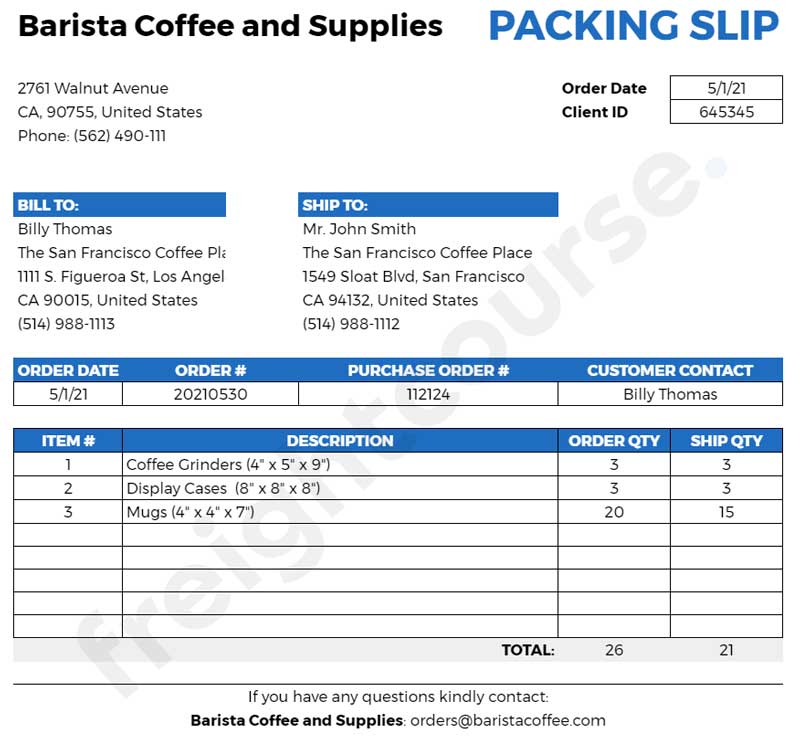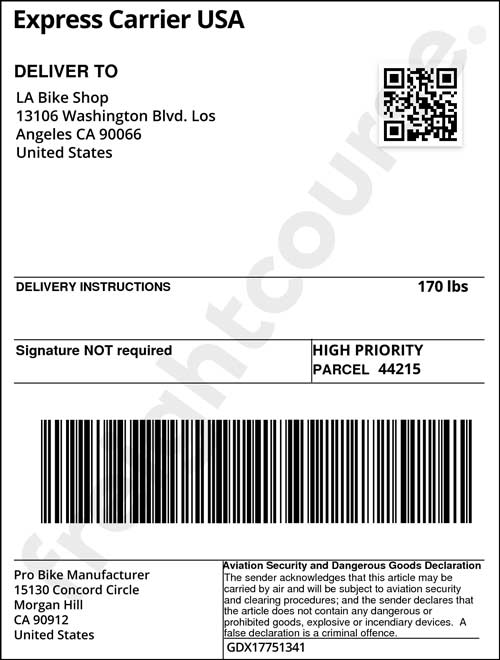Warehousing documentation can get confusing, especially when there are multiple slips, labels and sheets that need to be generated for each consignment. Furthermore, most of these documents have different requirements and are also prepared at different stages of the shipment process.
Two common shipping documents are the packing slip and the shipping label. While these two documents are parts of the warehouse documentation, they are often confused with each other.
The difference between a packing slip and a shipping label is that the packing slip is a document created by the shipper for the consignee that indicates information that is relevant to the order. On the other hand, the shipping label is a document that is also created by the shipper but is used by carriers that provides shipping information.
Here’s a quick summary of both documents:
Packing Slip:
- For the consignee
- Place into carton on pouch
- Container order information
- Typically one for the entire order
Shipping Label
- For the carrier or transporter
- Pasted onto the carton
- Contains shipping information
- One for each carton
In this article, we’ll be exploring the packing slip and shipping label documents in more detail and also highlight their similarities and differences. We’ll also establish during which part of the shipping process these documents are generated.
What Is A Packing Slip?
A packing slip is a document that is created by the shipper. It contains detailed information about the order, which includes the list of items that are being shipped, as well as the quantity, weight and destination.
It’s one of the most important documents when sending or receiving shipments, as the receiver is able to check if the right cargo was shipped to the right consignee and destination.
Alongside the transport document, such as a bill of lading, delivery order, consignment note or airway bill and the commercial invoice, the packing slip can also be used during export and import customs clearance. In that sense, it’s similar to a packing or stuffing list.
What Information is Found on a Packing Slip?
As the packing slip should contain all relevant order information for the consignee, this document typically shows the following information:
- Order Date: The time and date that the order was placed. An example for this is May 1, 2021. Certain shippers also indicate a timestamp of the order placement.
- Purchaser Name: The complete name of the buyer. This can be an individual, a public or a private company. For example: Billy Thomas / The San Francisco Coffee Place.
- Purchaser Address: The address details of the buyer. This includes the address lines, postal code, country and unit/block numbers. For example: 1111 S. Figueroa St, Los Angeles, CA 90015, United States.
- Recipient Name: The name of the recipient of the goods. This may not necessarily be the same entity as the purchaser. The recipient is the party who will officially receive the consignment. Mr. John Smith / The San Francisco Coffee Place – Lakeshore Plaza.
- Recipient Address: The address details of the recipient. The recipient address and the purchaser address do not need to be the same. For example: The San Francisco Coffee Place – 1549 Sloat Blvd, San Francisco, CA 94132, United States.
- Itemized List of Order: Details of the entire order that was placed by the purchaser. These items are listed. For example, Coffee Grinder, Toaster, Oven, Freezer, Display Case, Mugs, Espresso Cups, Sugar, and Plates.
- Itemized List of Shipped Items – A detailed list of items that were shipped in the consignment. These are typically broken down into quality and description. For example 3 Toasters, 2 Display Cases, and 50 Mugs.
- Itemized List of Items That Will Ship Separately: Items that are in the order but that are not inside this consignment. This could be due to a short shipment or due to other reasons. For example: Excluded are 3 of 5 Coffee grinders (quality issues detected during production).
- Item Specifications: This includes the number of items inside the consignment, dimensions, weight and occasionally SKU numbers. For example: 3 x Coffee Grinders, 3 x Display Cases, 20 x Mugs (with weight and dimensions of each item). The total weight and volume are also usually indicated.
- Seller Name: The name of the seller of the goods. This is also often the shipper, who is providing the packing slip. The seller and shipper could be for example Barista Coffee and Supplies.
- Seller Contact Information: Complete contact details of the seller. This field usually indicates the address, email, phone number and sometimes a contact person. Example: 2761 Walnut Avenue, CA, 90755. Phone number (562) 490-111. Email orders@baristacoffee.com.
- Packing Slip / Order Slip / Shipping Slip Number: This is an internal order reference number of the seller. This number is used for internal reference when creating documentation and processing the order. For example, Order Number: 20210530

Above is a sample of the packing slip document. As you can see, it contains all of the relevant information that is mentioned in the list above. Please note that not all packing slips necessarily contain the same information. These details ultimately depend on the arrangement between the buyer and seller.
What is a Shipping Label?
On the other hand, shipping labels are used by carriers and transport vendors to support the overall shipping process. Firstly, it helps them to keep track of shipments; secondly, it helps them identify the right shipment details.
As transport vendors have a lot of cargo to move it’s important that the process, as well as the documentation, specifically the shipping label contains all of the relevant information they need.
Therefore, it’s important to ensure the shipping label is accurate, as failure to do so can result in cargo losses, mishandling and misrouting. An accurate shipping label can prevent monetary claims that may arise from the potential issues listed above.
What Information is Found on a Shipping Label?
Depending on the shipper, carrier or transport agent, shipping labels can contain different information. Below is an example of the most common fields on a shipping label:
- Carrier Tracking Number / Barcode / QR code: This is an internal tracking number that is used by the carrier to move and track the cargo. More advanced carriers even use a barcode or a QR code for scanning purposes. This helps them to determine the place of origin or destination, ETD / ETA, cargo status or events, flight numbers, and data needed for shipment planning.
- Shipping Date: This date refers to when the cargo is shipped. This is often the date when the cargo is firstly moved by the carrier or transport agent. It’s often the pickup date. Example: 21/4/2021.
- Shipping Priority: This is often seen in airfreight shipments to mark the priority level of a particular shipment. Example: Priority is marked as urgent, express delivery or standard delivery.
- Shipper Name: The name of the shipper, which is often also the seller. Example: Pro Bike Manufacturer.
- Shipper Address: The address details of the shipper. This information is used by the carrier to get in touch with the shipper in case of inquiries or discrepancies. Example: 15130 Concord Circle, Morgan Hill, CA 90912, United States.
- Consignee Name: The name of the recipient to whom the shipment is consigned to. Example: LA Bike Shop.
- Consignee Address: The address of the recipient of the goods. Example: 13106 Washington Blvd. Los Angeles CA 90066, United States.
- Weight: The weight of the cargo that is being shipped. Example: 170 bs (77.11 kg).
- Delivery Instructions: These are special instructions for delivery. For example, they may request to call a person upon delivery or to leave it at the doorstep.

Above is a sample of the shipping label document. Most carriers and transport agents use a similar layout with similar information.
Packing Slip vs Shipping Label: Are They The Same?
Having gone into detail on packing slips and shipping labels, it’s apparent that both documents are different. This is because each of these documents serve a different purpose.
To highlight again, packing slips are created for consignees so that they are aware of the order and consignment details. They are able to see what they have ordered and what has been fulfilled.
The shipping label is a document that is pasted onto the packaging and helps the carrier to identity and track the shipment. Therefore it contains all relevant shipment details such as the shipper and consignee information.
A shipping label would also have a barcode or QR code to facilitate easy cargo tracking on a day-to-day basis. This is not required for packing slips, as it mainly contains order information.
Additionally, a shipping label is attached to each carton, whereby a packing slip is often attached to a pouch or placed inside the carton. There is often only one packing slip for multiple cartons, as it contains the entire order.
Both packing slip and shipping label contain common data fields such as the shipper, consignee, weight, and delivery address. This is about the only similarity that both of these documents have with each other, apart from the fact that they are both documents in the shipping process.
Should You Always Use Both Packing Slip and Shipping Label?
It is best practice to have both a packing slip and a shipping label for every shipment that is fulfilled. This is because the packing slip gives the buyer a heads-up of the merchandise that has been purchased and will be included in the actual shipment.
While packing slips are not mandatory, it’s highly encouraged due to the above mentioned reasons. On the other hand, shipping labels are mandatory, as carriers will not be able to move your cargo without it.
Furthermore, the shipping label ensures the valuable cargo gets transported, customs cleared, and delivered. A properly filled up packing slip and shipping label lessen the chances of cargo being mishandled, held for various reasons, examined, or subjected to additional fees.

Get Free Course Access
If you enjoyed the article, don’t miss out on our free supply chain courses that help you stay ahead in your industry.

Andrew Lin
Co-Founder & Writer
at freightcourse
About the Author
Andrew is a multi-business owner with over 12 years of experience in the fields of logistics, trucking, manufacturing, operations, training, and education.
Being the co-founder of freightcourse has given him the ability to pursue his desire to educate others on manufacturing and supply chain topics.
Follow us